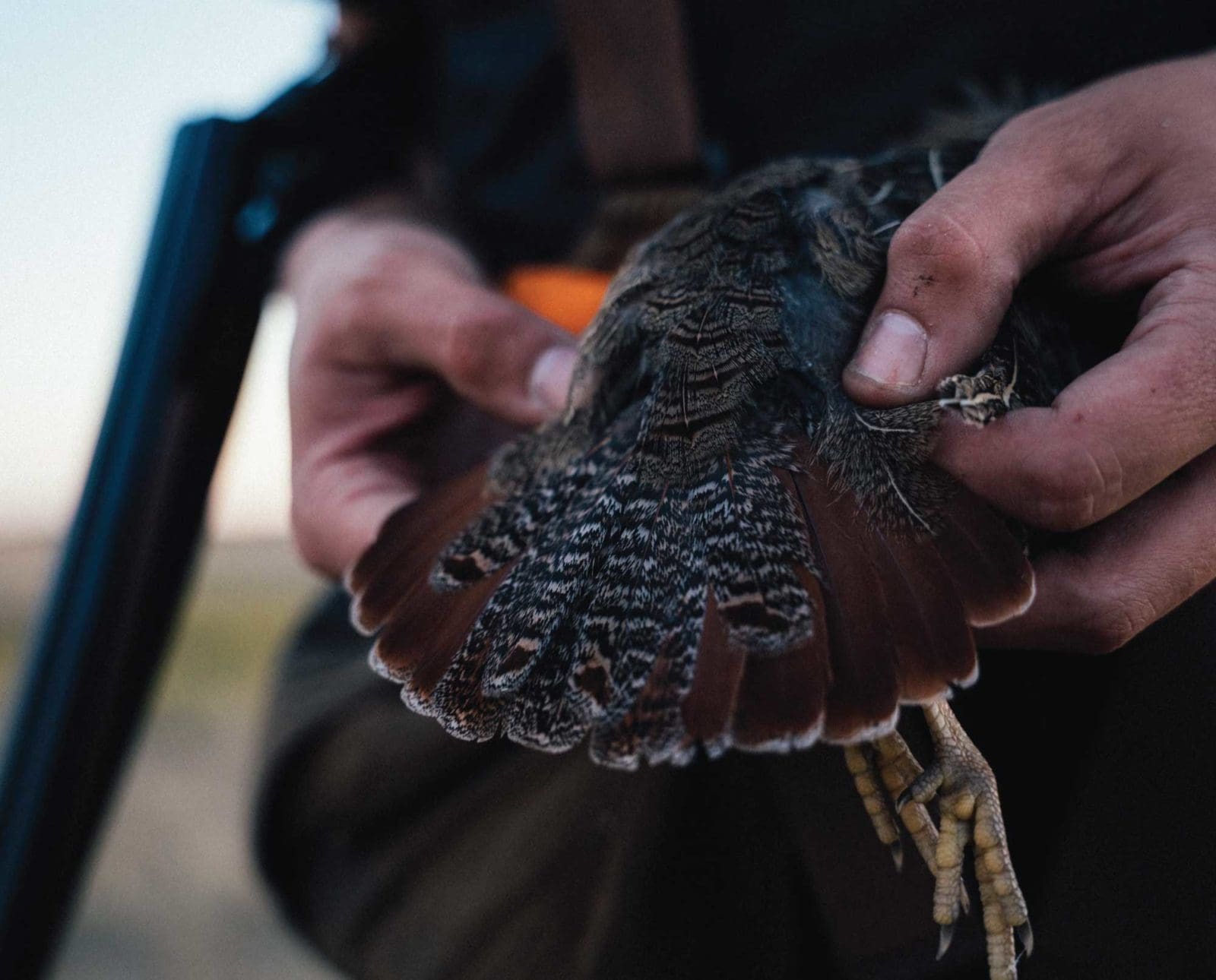Home » Partridge Species » Hungarian Partridge Hunting » Hunting Huns in Montana
Hunting Huns in Montana

Michael R Thompson is an independent artist and custom knife…
These under-appreciated gray birds present wonderful hunting opportunities in a variety of habitats
Hungarian partridge, or gray partridge, are as much a part of the western uplands as any other nonnative game species that has found a permanent home in the landscape and our hearts.
Pheasants are the glory bird, conniving and frustrating to hunt. A late-season rooster will make some of the most well-trained dogs come unraveled while trying to put up with this bird’s antics. Whether or not you like them, a limit of roosters hanging on a fence post at the end of the day has an undeniable gravitas.
Wild chukar are the notorious devil birds that you hunt once for fun and again for revenge. Their chosen home is best suited for those with young knees or unyielding determination. A single chukar in the hand is equally impressive as a limit because it tells the unspoken story of how you and your dog worked your tails off and didn’t give up. Chukar will often play by the rules, but they do this on their home turf where getting to the dog on point seems slightly less difficult than reaching the moon.
But of the three most common introduced birds of the western uplands, what do people have to say about Huns? They aren’t as notorious as chukar hunting, but I’d wager they are much more common with huntable populations in numerous states and provinces where the mighty chukar cannot find habitat. Huns aren’t as frustrating as pheasants, although in the late season they can produce more than enough frustration for any dog and hunter combo willing to brave the winter winds. Huns are affable, they are accessible, and they are inviting. When I see someone posing with a limit of gray partridge, with maybe a sharptail or two tucked in for filler, the word “epic” doesn’t come to mind at first. I usually think, “Good for them! They had a nice hunt.” A limit usually means (if you aren’t a greedy covey-stomper) that you had multiple examples of good dog work throughout the day, some fast-challenging shooting, and of course some great meals to come.
Shooting Hungarian partridges
Are Huns hard to hit? I think so—as hard as any covey bird with numbers enough to lend a moment of confusion to the shooter. For me, at least, they are tougher than chukar to consistently hit but much easier than the infuriating California quail whose habitat often overlaps.
Huns can be taken for granted. I’m not sure I’ve purposefully sought Hungarian partridge out on their own; maybe that is why I am so fond of them, because my relationship hasn’t gone past the flirtation stage. They were always there on the periphery when I was after chukar, pheasant, or prairie grouse. Sooner or later, during the pursuit of the aforementioned three, you will probably bump into a covey of Huns. Many an unsuccessful chukar or prairie grouse hunt has wound up a successful Hungarian partridge hunt, thanks to the almost ubiquitous nature of these small, gray, and rusty birds within their range.
It’s not that Huns don’t have a lot to offer. The “screen door slam” sound of a covey of Hungarian partridges flushing will get your blood pumping as hard as the buzz-bomb fury of a covey of bobwhites. They hold beautifully for pointing dogs in the early season and teach your dog how to be judicious in the late season by not tolerating crowding. They aren’t hard to bring down—a couple 7.5 pellets will anchor them—and generally, wounded birds don’t run out of the county like a broken-winged rooster would, although there will always be exceptions.
Finding and pursuing Huns in their habitat
Huns aren’t hard to find once you know what you are looking for and, more often than not, you will find the same covey in the same area year after year. There is a covey in central Montana that I found on my very first upland hunting trip to the state. They were near a cattle tank that overlooked vast stubble. Behind the tank was a thin draw that pulled up the rolling hills like a brush stroke. I was overwhelmed and didn’t know what I was doing, but I found success with that covey. Every year when I returned to Montana, that covey’s home territory would be one of the first places I would visit to help take the edge off my uncertainty about hunting in an unfamiliar landscape. Sure enough, relatives of those very first Montana gray partridge I found would be somewhere in the same draw or nearby stubble.
Huns can often be easy to relocate after they flush. In their native Hungarian and formerly Czechoslovakian steppes, hunters would flush them on horseback, then relocate and flush them again, and repeat until the birds were so exhausted that they could be approached and have a net thrown over them. Today, flushing the same covey multiple times is frowned upon. To keep a covey healthy, it’s best to only take one or two birds and move on; otherwise, it’s easy to wipe them out. Note that this applies to all covey birds, not just the hun.
The preferred habitat of Huns is wheat stubble and grassland, similar to the steppe where they evolved. This habitat begs for a big-running dog to effectively cover, but Huns can be found and hunted just as successfully with a flushing dog if you work structure like a bass fisherman: seek out edges, eyebrows, old farmhouses gradually being eaten by the wind. . . anything that is different in all that grass.
But then, as I mentioned before, Huns are where you find them. I have found coveys in high altitude slopes where the tree line starts and the cheat grass ends. You would be less surprised to see a blue grouse in this spot than you would to see some little farmland birds. I have bumped into them while sage grouse hunting—a harsh environment where I thought that such an innocent little bird had no business scratching out a living. I have seen them flush out of ruffed grouse cover a quarter-mile away from any farmer’s field that typically makes me think “Hun.”
Are Huns worth a dedicated pursuit?
Are Huns easy to hunt? Is that why they don’t get the respect of the people that hunt their chukar cousins? Is their affability the very thing that makes them uninteresting and unworthy of upland celebrity status? As far as table fare goes, they are right up there with chukar and usually don’t have the same musty funk flavor that often accompanies the devil bird. You can cook them the same way you would a quail, but with a little more meat. Their breast meat is light-colored and delicate, with a freshness that reminds me of cold winter winds. They bring a “come as you are” quality to the table that begs for plucking and cooking whole with your favorite herbs and a simplicity that a good pan sauce can always highlight. Be that as it may, I will never turn down hun tacos. This is everyone’s bird and, as agreeable as it can be in the field, so it is on the table.
The first Hun I ever saw was a case of mistaken identity. I was visiting a friend at Washington State University in Pullman, Washington, for a pheasant hunt in the nearby rolling hills. We had spent most of the first morning getting turned down for private land permissions. When we finally found a landowner that granted access, he requested that we “shoot up all those quail that scare the heck out of while she was walking the dog.” We found a few pheasants. One flew up into a knob of stubble up above the creek we were working. My Springer spaniel and I pursued it for an unlikely reflush when all of a sudden, WHAFF! A covey of birds got up and flew right into the sun. I fired and one fell; what my dog brought back was not a quail at all, but a beautiful gray bird with a rusty, red brick-colored chest. I marveled at the unexpectedness of it all. Being young and greedy, I found the covey two more times and took a bird from each flush. Thus began a lifelong flirtation with and appreciation for the gray partridge.
There is a peacefulness and honesty about the pursuit of Huns that sometimes gets lost in the details when pursuing other birds. Maybe it’s that the hunt is usually conducted right out in the open and that Huns usually play by the rules—except for when they don’t. A late season hunt in fresh snow revealed some very cunning treachery on the part of the gray partridges. The dogs were working scent but not finding the birds at the end of it. Looking at the telltale tracks in the snow revealed a covey of birds that scattered in every direction but ours. Their trails wound through the sage clumps and corkscrewed around the bits of cheat grass that the snow didn’t push down. At this point I thought we were going to be finding singles, until WHAFF!!! The whole covey burst out from under a large sage plant. I missed with both barrels and didn’t reload fast enough for the three late flushers that came out of the very same sage plant. Huns will surprise you.
Now I am a Montana resident with a laundry list of upland birds to choose from, but I hold a secret suspicion that I could be completely content following big-running dogs across the stubble and grasslands exclusively for small gray birds that will hold long enough for me to catch up with the dog, but still have enough surprises under their wings to keep me guessing.
Michael R Thompson is an independent artist and custom knife maker living in the Bitterroot valley of Montana with his setters and labs.




I love eating huns, an upland bird that doesn’t taste like chicken but they are not the sporting bird that chukars are. Usually, we get them on the edge habitat where they’re mixed with chukars. Twice I have shot once and dropped three huns! We say they die of a heart attack at the sound of the gun. Huns are for us always incidental to hunting something else. We appreciate them but never go out specifically hunting for them.
In the words of Winston Churchill “The Hun is always either at your throat or at your feet.” Shoot them when you see them.😀
Most people I have talked to, have said that huns are a bonus bird. I have seen more huns than sharpies. New to hunting both species. Had hard hunting cover so short. First covey I found was last season midway through. Reminded me of scaled quail. Found a couple this season so far. They do hold nicely early season. Just wish they knot running the gun would connect.